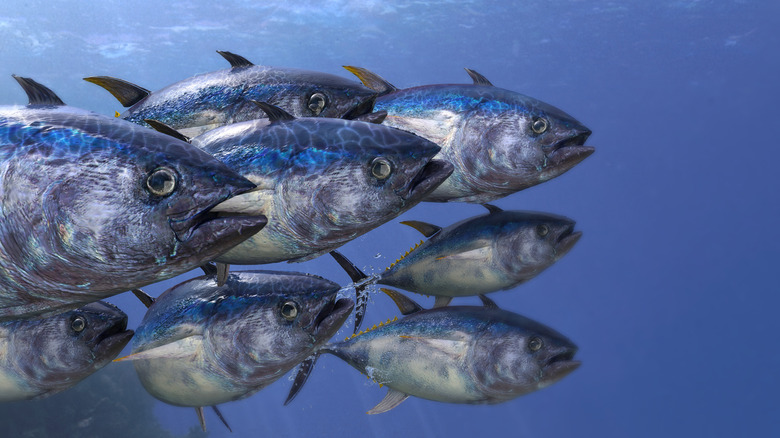Why Is Tuna Called The Chicken Of The Sea?
Let's be honest — a can of tuna can be pretty polarizing. You're either a tuna person who revels in its fishy goodness and loves to eat tuna sandwiches packed with mayo and celery for lunch, or you simply abhor the sight and smell of it. But whether you like tuna or not, we can all agree on one thing — we know it as the "chicken of the sea."
Maybe it's because you frequently see Chicken of the Sea-branded tuna on your grocery store shelves, or maybe it's thanks to that iconic episode of "Newlyweds: Nick & Jessica" when Jessica Simpson finds herself genuinely confused about whether she's eating chicken or fish. Regardless, today we all know that when someone says, "the chicken of the sea," they're referring to tuna fish.
We're here to answer the big question: Why is tuna called "the chicken of the sea" in the first place? Fittingly, it all started at sea.
A fisherman phrase that became a brand identity
It's the early 1900s. A fisherman spots a school of metallic-skinned albacore tuna swimming in the water. He yells, "Chicken of the sea!" His crewmates all know exactly what he's talking about.
According to Chicken of the Sea and an ad published by the brand in 1973, this scenario played out at sea as a sort of ongoing joke between tuna fishermen. They had dubbed albacore tuna "the chicken of the sea" because of its delicate white meat. The phrase is obviously what inspired the company's name, but it wasn't branded as Chicken of the Sea until 1930 — more than 15 years after the company began as Van Camp Seafood.
Why albacore, specifically? Because that's actually the only species of tuna that can be labeled as "white," and its meat has a milder, less fishy flavor that's comparable to chicken. Many tuna brands sell all different kinds of canned tuna, so now you know — if you want the real chicken of the sea, go for the tuna cans labeled "white."
What's the difference between white and light meat tuna?
Aside from white meat tuna, most other kinds of canned tuna you'll see on the shelf fall under the category of light tuna. So, what exactly is the difference, and is the real "chicken of the sea" the better choice? Ultimately, it comes down to personal preference.
White tuna, as mentioned above, is more moderate in taste. It has white or light pink coloring and semi-firm texture. Nutritionally, it contains more omega-3 fatty acids and is a little higher in fat. Because it's milder by nature, white tuna works well in recipes where you don't necessarily want a lot of fish flavor.
While white tuna is 100% albacore, light tuna includes several varieties of fish, like yellowfin and skipjack. A can of light tuna can either contain one variety of fish or a combination of several. In comparison to white tuna, light meat has a more potent, fishy flavor; its coloring is darker, and its texture is softer. Light tuna is great for things like tuna salad or tuna melts where you want the quintessential flavors of tuna fish to shine.


